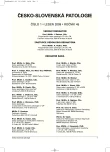-
Medical journals
- Career
Histological Differential Diagnosis of Hydatidiform Moles and Hydropic Abortions
Authors: M. Zavadil; J. Feyereisl; V. Hejda; L. Krofta; P. Šafář
Authors‘ workplace: Ústav patologie 3. LF UK a FNKV, Praha 1; Oddělení patologie a molekulární medicíny, FTNsP, Praha 2; Dermatohistopatologická laboratoř, Praha 3
Published in: Čes.-slov. Patol., 45, 2009, No. 1, p. 3-8
Category: Original Article
Overview
Objective:
To describe the diagnostic methods enabling histological differential diagnosis of complete hydatidiform mole, immature complete hydatidiform mole, partial hydatidiform mole, proliferative mole and hydropic abortion.Methods:
Our study consists of 1321 partial hydatidiform moles, 805 complete hydatidiform moles, 524 proliferative moles, and over 2500 hydropic abortuses diagnosed and treated at the Trophoblastic Disease Center in the Czech Republic (TDC–CZ), Institute for the Care of Mother and Child, plus 2896 of these lesions examined at the TDC–CZ by referral. The material was examined by routine histopathological methods, which in selected cases were supplemented by immunohistological examination and correlated with cytogenetic and molecular genetic results and clinical features.Results:
The study describes the diagnostic procedures enabling differential diagnosis between mature complete hydatidiform mole, immature complete hydatidiform mole, partial hydatidiform mole, proliferative mole and hydropic abortion. Fourteen histological parameters have been defined which are most common, individually or in combination, in various types of hydatidiform moles and hydropic abortions. Warning is given to errors in histological diagnosis, correlated with cytogenetic and molecular genetic results. We propose a reliable method of eliminating the influence of these errors on the possible development of trophoblastic disease.Conclusion:
The study describes a histological differential diagnosis of complete hydatidiform mole, immature complete hydatidiform mole, partial hydatidiform mole,proliferative mole and hydropic abortion.Key words:
complete hydatidiform mole – immature complete hydatidiform mole – partial hydatidiform mole – proliferative-invasive mole – hydropic abortion – differential diagnosis
Sources
1. Bagshawe, K.D., Lawler, S. D., Paradinas, F.J. et al.: Gestational trophoblastic tumours following initial diagnosis of partial hydatiform mole. Lancet 335, 1990, s. 1074–76.
2. Fukunaga, M. Ushigome, Sand E. Y.: Incidence of hydatiform mole in Tokyo hospital: a 5 years (1989–1993) prospective morphological and flow cytometric study. Hum. Path., 26, 1995, s. 758–64.
3. Hemming, J. D., Quirke, P., Womak, C. et al.: Diagnosis of molar pregnancy and persistent trophoblastic disease by flow cytometry. J. Clin. Path., 40, 1987, s. 615–20.
4. Hertig, AT., Edmonds, H.W.: Genesis of hydatiform mole. Arch. Pathol., 30,1940, s. 260–91.
5. Kajii T., Kurashige, H., Ohama, K., Uchino, F: XY and XX complete mole: clinical and morphological correlations. Am. J. Obst. Gyn., 150, 1984, s. 57–64.
6. Lage, J. M., Mark, S.D:, Roberts, D.J. et al.: A flow cytometric study of 137 fresh hydropic placentas: correlation between types of hydatiform moles and DNA ploidy. Obst. Gyn., 79, 1992, s. 403–10.
7. Lage, J.M., Weinbery, D. S., Yavner, D.L., Bieber, F.R.: The biology of tetraploid and hydatiform moles: histopathology, cytogenetics and flow cytometry. Human Path., 20, 1989, s. 419–25.
8. Lawler, S.D., Fisher, R.A., Dent, J.: A prospective genetic study of complete and partial hydatiform moles. Am. J. Clin. Path., 164, 1991, s. 1270–7.
9. Maggiori, M. S., Peres. L. C.: Morphologic, immunohistological and chromosome in situ hybridization in the differential diagnosis of hydatiform mole and hydropic abortion. Eu. J. Obst. Gyn., 135, 2007, s. 170–176.
10. Miller, R. T.: Evalution of hydropic placentas (hydropic degeneration vs. partial mole vs. comlete mole). March 2003 www.propathlab.com
11. Ober, W.B., Fass, R. O.: The early history of choriocarcinoma. Journal of History of Medicine and Allied Sciences, 16, 1951, s. 49–73.
12. Paradinas, F.J. Browne, P., Fisher, R.A. et al.: A clinical histopathological and flow cytometric study of 149 complete moles,146 partial moles and 107 non - molar hydropic abortions. Histopathology, 28, 1996, s. 101–9.
13. Park, W. W.: Disorders arising from human trophoblast. Modern Trends in Pathology. Butterwoths, London, ed. D.H. Collins. 1959, s. 180–211.
14. Ramaguera, R. L., Rodriguez, M., M., Bruce, J., H., et al.: Molar gestation and hydropic abortions differentiated by p 57 immunohistostainig. Fet. Ped. Path., 23, 2004, s. 181–190.
15. Suresh, U., R.: Use of proliferation cell nuclear antigen immunoreactivity for distinguishing hydropic abortion from partial hydatiform moles. J. Clin. Path. 46, 1993, s. 48–50.
16. Szulman, A.E., Surti, U.: The syndromes of hydatiform mole. I. Cytogenetic and morphological correlations, Am. J. Obst. Gynec. 131, 1978, s. 665–71.
17. Szulman, A.E., Surti, U.: The syndromes of hydatiform mole. II. Morphologic evaluation of the complete and partial mole. Am. J. Obst. Gyn. 132, 1978, s. 20–27.
18. Vassilakos, P., Riotton, G. Kajii, T.: Hydatiform mole: two entities. A morphologic and cytogenetic study with clinical considerations. Am. J. Obst. Gyn., 127, 1977, s. 167–70.
19. World Health Organisation Scientific Group: Gestational trophoblastic diseases. Technical Report . 1983, Serie 692.
20. Zavadil,M.: Trophoblastic disease I–III. Acta Univ. Carol. Med. 19, 1973, s.1–107.
Labels
Anatomical pathology Forensic medical examiner Toxicology
Article was published inCzecho-Slovak Pathology

2009 Issue 1
Most read in this issue- Histological Differential Diagnosis of Hydatidiform Moles and Hydropic Abortions
- Post-Radiation Dedifferentiation of Meningioma into Chondroblastic Osteosarcoma
- Merkel Cell Carcinoma – Immunohistochemical Study in a Group of 11 Patients
- Diagnostic Possibility of Celiac Disease in Bioptic Practise
Login#ADS_BOTTOM_SCRIPTS#Forgotten passwordEnter the email address that you registered with. We will send you instructions on how to set a new password.
- Career
